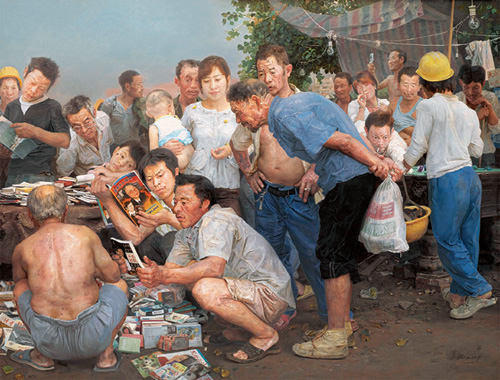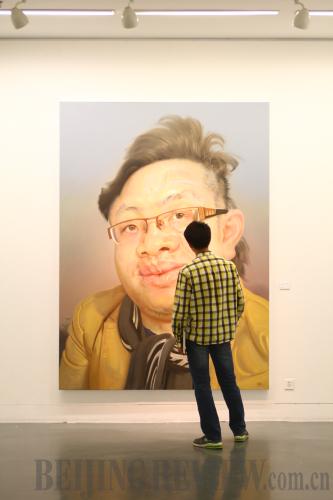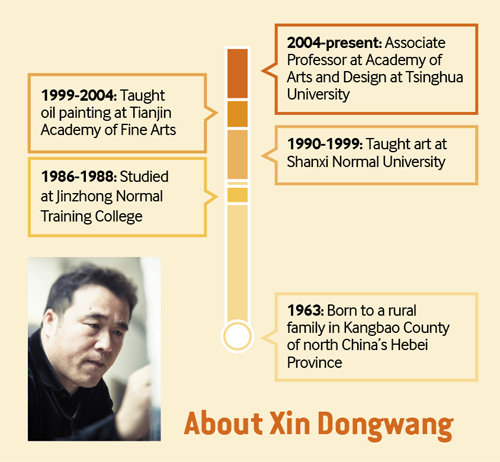|
 |
|
Quench the Summer Heat, painted by Xin Dongwang in 2009 (COURTESY OF THE GALLERY OF TSINGHUA UNIVERSITY) |
"My roots lie in rural areas, even though I have spent quite some time away from the traditional lifestyle of my hometown. I have a natural bond with country folk, so does my art," painter Xin Dongwang told Beijing Review during his solo exhibition at the Gallery of Tsinghua University in Beijing on May 17.
For his latest exhibition, the painter has included work that range beyond rural workers and depict merchants, Tibetan monks and expats living in China.
Xiang You Xin Sheng, the title of Xin's show, is derived from a Chinese phrase indicating that a person's face reveals the inner workings of the soul. The exhibition includes more than 100 pieces in oil and sketches finished after 2006.
"Looking at the portraits of such common people, I am touched by their faces, which look so alive and real," said an art lover from Inner Mongolia Autonomous Region visiting the exhibition.
The portrait painter, 50, is an associate professor of the Academy of Art and Design at Tsinghua University. In accordance with the Confucius' saying that a man will know his destiny at the age of 50, Xin clearly understands what he wants to paint and how to do so. He regards his solo show as a periodical summary of his art.
In 1963, the artist was born to a rural family from a remote village in a vast prairie in north China. Xin did not want to follow in his father's footsteps and lead a harsh, cold life on the steppes. His mother, excellent at the traditional Chinese folk art of paper cutting, was subsequently responsible for planting the creative seed in her son's heart. Xin decided to be a painter and explore the world. At age 17, he left home for a neighboring county to learn painting. In the years that followed, Xin moved around often in pursuit of artistic refinement.
"The path to becoming an artist was hard, but I have never lost my confidence and passion," he said. "Even being a coal miner in Shanxi Province for a while didn't stop me from painting."
Xin became an art teacher at Shanxi Normal University in 1990. As a young artist, his work in watercolor and oil achieved some level of success at national exhibitions and contests.
However, the painter struggled to find direction until, one day in 1995, he was inspired by a scene on a train station square, crowded with rural workers from his home town waiting to return home for Spring Festival, which normally falls on January or February each year.
Realizing the plight of millions of such workers, who, due to social and economic development in China, have left their hometowns and families to earn what little cash they can and endure many hardships in cities, Xin finally found his subject.
"These workers are symbols of the change we are experiencing," the painter said. "Artists should stick to the times and capture reality," Xin added. "Rural people have gained little respect, even though they have made such a great contribution to urbanization since the 1980s."
 |
|
IMPRESSIVE FACE: A viewer observes a big portrait painted by Xin Dongwang at the Gallery of Tsinghua University in Beijing on May 17 (SUN SHIQI) |
The painter has created hundreds of portraits based on the real lives of people since 1995, arousing much attention and praise. Town of Modesty (1995), Xin's first realist oil portrait of rural workers, won the silver medal at the Third Chinese Oil Painting Annual Exhibition while Breakfast, painted in 2004, won the gold medal at the 10th National Fine Arts Exhibition held the same year.
Despite the sense of realism, the figures in Xin's works feature his own aesthetical ideas, most depicted as shorter and more compressed than usual.
"The people I paint experience vast amounts of pressure on a daily basis. Exaggeration helps viewers understand the impact of such lives," he explained.
Most of Xin's portraits feature foreheads, which the artist says he struggles to capture, painted in thick oil colors to represent the inner workings of the mind, despite their usually flat surfaces.
"Oil is a rich and expressive medium, through which I have managed to translate people's thoughts and ideas to make them stand out," he said. For example, frowns represent pressure and anxiety, while a creaseless forehead reveals inner peace, he added.
Email us at: baishi@bjreview.com

| 